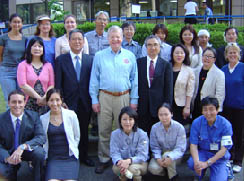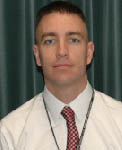U.S. Embassy First Friday
Jeffrey Weinshenker
Former Vice Consul
U.S. Embassy Tokyo
Community service has always been an important part of my life. Volunteering enriches the lives of everyone involved, and helps lift up those in need. When I first arrived at Embassy Tokyo in January 2006, I eagerly sought opportunities to give back to the local community. I was encouraged to find a strong spirit of volunteerism within the Embassy community and a history of successful, ad hoc outreach activities. At the same time, I noticed that many Embassy staff were anxious to volunteer but did not know where to begin. Volunteerism is not as common in Japan as in the U.S., and the language barrier frequently made it difficult for non-Japanese speakers to track down existing opportunities.

Ambassador Schieffer (center) with volunteers from the U.S. Embassy, including Jeffrey Weinshenker (front left) and Sarah Okawa (second from the left in the front) (Photo from Embassy Tokyo)
In order to capitalize on this community service spirit, I decided to team up with Sarah Okawa, a local employee at the Tokyo American Center with a similar passion for volunteerism, to create a more formal Embassy volunteer program. With the strong support of Ambassador Schieffer, we launched “U.S. Embassy First Friday,” an official Embassy-sponsored program designed to promote community outreach through monthly volunteer events in the Tokyo area.
Since its inception in June 2007, “First Friday” has brought together countless Embassy volunteers – both American and Japanese, as well as family members – on the first Friday of every month to reach out to neighboring communities and assist with a wide range of charitable causes. To date, “First Friday” teams have:
- Picked up trash and planted flowers in downtown Tokyo;
- Mentored disadvantaged youth from Nonohana-no-Ie Children’s Home;
- Given a musical performance and delivered baked goods to an Akasaka nursing home for Alzheimer’s patients;
- Helped prepare meals for the Second Harvest food bank that provides food to local soup kitchens;
- Visited a Japanese elementary school to share American music and culture; and
- Performed a holiday concert at Ariake Cancer Institute Hospital.
Ambassador and Mrs. Schieffer have been active participants in “First Friday” events, and the Ambassador has made sure that interested staff members are given time off from work to volunteer.
While reaching out to the local community is our top priority, we have also accomplished a secondary goal: breaking down cultural boundaries for all involved. Whether we’re singing songs with hospital patients, playing sports with kids, or enjoying afternoon tea with a group of handicapped individuals, we are bringing together people of different cultural backgrounds and making an impact on a person-to-person level. This, in my opinion, is what public diplomacy is all about. “First Friday” has helped foster a spirit of friendship between the U.S. Embassy and the Japanese community.
Thus far, the response from both volunteers and those served has been tremendously positive. As we move forward in 2008, many more events are in the works. I am very grateful for the participation and support we have received both inside and outside of the Embassy, and would like to wish “First Friday” continued success in the time ahead.
Toys for Orphans

USMC GySgt Daniel Mangrum, U.S. Embassy Tokyo
American View: Could you tell us about the Toys for Orphans program?
GySgt Mangrum: Each year, we start collecting toys in mid-November. Embassy employees donate new toys, which are distributed to orphans here in Japan. Support was so good this past year that we were able to provide toys to 93 children in two different orphanages, giving around two toys per child. In addition to that, different sections in the Embassy were able to come up with some money that we used to purchase a hat and a set of gloves for each child. In addition, we gave each of the orphanages a cash donation of around 50,000 yen. Single mothers live at one of the orphanages, and we provided 10-15 of them with new makeup kits, and we gave chocolates and flowers to the staff at both places. I hope we can make an ever bigger impact next year.
Q: How are the gifts given to the kids?
GySgt Mangrum: I and three other Marines put on our dress blues and passed out the presents ourselves, along with some help from my wife and our two daughters, as well as a Japanese staff member from the Embassy. Our group took a bus to the orphanages and handed out presents while the children were in class. The toys are always wrapped and tagged by gender and age to ensure that the kids get a suitable toy. We stayed and had lunch with the kids in the first orphanage, talking with them, playing together, and taking pictures together. It was the same thing at the second orphanage.
Q: What was the reaction of the kids?
GySgt Mangrum: Absolute joy. A lot of the children were fascinated with our uniforms and wanted to touch them and wear our hats. All the Marines really enjoyed the chance to interact with the kids, and the event had a good impact on the younger Marines. My daughters, who are four and two, also had a great time helping pass out presents. My four-year-old, in particular, sang some Christmas songs for the kids.
Q: What is the significance of this program?
GySgt Mangrum: For us as Americans, Christmas is the season of giving. For me, just putting a smile on the face of a kid is significant enough, especially for orphans.
Q: Do the Marines also benefit from this program?
GySgt Mangrum: Absolutely. That might have been the first time many of those kids have ever met an American, much less a U.S. Marine, and now they’ll remember the Marines as those guys who came and brought them presents that day – a first impression is a lasting impression.
Life in the Peace Corps
Erin Eddy
Vice Consul
U.S. Embassy Tokyo
American View: How did you become interested in volunteering?

The kitchen in the house where Eddy and the other volunteers lived in Ecuador. (Photo from Erin Eddy)
Eddy: I was brought up in a tradition of volunteering, coming from a family that values the chance to help the community. Throughout childhood, I always had fantastic opportunities to join volunteer projects through school, church and community-sponsored events and drives. While I was an undergraduate, I was a volunteer coordinator and tutor in a literacy program that reached out to inner-city elementary kids. Volunteers would usually stay with the same child in the program for the three or four years, so it was a valuable commitment for everyone involved.
Q: What was the Peace Corps like?
Eddy: After a long application process, I was selected to go to Ecuador as a health education volunteer soon after I graduated from college. There were about 27 people in my Omnibus, which is what the training groups are called. We did three months of technical training and Spanish language study just outside Quito before going to our individual sites, where we lived and worked with the village community for two years. I was matched with a remote village that was essentially an island at high tide; there were no paved roads, and trucks could only drive across the packed sand at low tide. Trips in and out of the village had to be timed with the tides.
Q: What kind of work did you do there?
Eddy: One of the first projects I worked on with the community was to construct properly placed latrines, away from the delicate mangroves. I also conducted HIV/AIDS prevention education programs, which involved talking with high school students about preventing the spread of HIV/AIDS. I was involved in family garden projects because there was a vitamin A deficiency in the region, so growing and eating foods like carrots and papayas was important. I also started a women’s group for new mothers to learn about the importance of breast feeding along with sterilizing baby bottles – just one drop of contaminated water is enough to make an infant seriously ill. The risk of various infections in a rural, tropical area is quite high even with knowledge and commitment to preventative measures, and I was also sick with one thing or another much of the time I was there.
Q: What was the reaction to your work from the local people, and how was your relationship with them?
Eddy: When I went with Ecuadorian health workers upstream by boat to remote villages for polio and tetanus vaccination day, for example, I would often be the first foreigner any of the locals had ever met. They were curious, grateful, and very generous with their friendship in return.
Music was one of the shared interests that helped me get more involved in the community and make connections with the people of Cojimies outside of official programs. I played violin since childhood, and I had always wanted to learn to play the guitar, which seemed to be the most popular instrument throughout Ecuador. There are similarities between the two instruments, and I was thrilled to learn some of Ecuador’s traditional folk songs. They, meanwhile, couldn’t get enough of my version of “Hotel California” which was very popular in coastal Ecuador at the time. I have so many great memories of time spent with my Ecuadorian friends and neighbors.
Q: What did you take home from your Peace Corps experience?
Eddy: I came to realize that one never knows how someone is going to impact one’s life; also that I might be able to make a meaningful difference in someone’s life. Before I departed, people told me how much my friendship and work had meant to them. The experience put things in perspective for me with regard to what is really important. I’m glad I volunteered when I had the opportunity to serve.
The Combined Federal Campaign

The CFC logo
Katherine Giles-Diaz
Program Development Officer, Public Affairs Section
U.S. Embassy Tokyo
American View: What is the Combined Federal Campaign?
Giles-Diaz: It’s a program that was organized in 1961 to provide federal employees a coordinated way to contribute to charitable organizations.
Q: Where does the money go?
Giles-Diaz: It goes to all sorts of charities, and that’s what’s great about the CFC. Federal employees can choose from among any of hundreds of charities. The CFC coordinators in Washington do research on those charities and provide information on them so that employees can make an informed decision about what they want to support, be it environmental programs, women’s shelters, or something else – there are all sorts of choices. It’s very convenient for employees, as the money is deducted from their pay every payday, and it’s tax deductible.
Q: There’s a CFC campaign in the fall. What does that involve?
Giles-Diaz: Volunteers at federal workplaces in the U.S. and at U.S. embassies worldwide coordinate within their offices, and distribute catalogues and other materials to encourage participation. The campaign runs for about two months from October to December, and employees who express an interest are given pledge cards for contributions the following year.
Q: How much do people give?
Giles-Diaz: It varies. Some people may give $5 a pay period, while others may give hundreds of dollars a pay period. It’s quite amazing, actually. In the U.S. Mission in Japan this year, we totaled over $30,000. USG-wide, it was around $270 million.
Q: Does the scale of the CFC make it more effective?
Giles-Diaz: Absolutely. While the bureaucracy is often seen as monolithic, in this situation, I really think it’s the bureaucracy that makes it so effective, because it takes a huge organization and uses that strength of numbers to coordinate something like this. This is a win-win situation for all involved – it’s convenient for employees, and it helps the charities, as well. If the charities had to reach out by themselves, there’s no way they could reach so many people, and this campaign means lower administrative costs for them, too. This is just a very effective way of getting money to charities.
Q: What do you think is the benefit of giving to charity?
Giles-Diaz: I can only speak from personal experience, but I feel I’ve been very lucky and have had many advantages. I’ve had help at different times along the way growing up and going to college, and I personally feel that I just want to give something back. It’s also a good way to demonstrate support for a cause you believe strongly in.







COMMENTS0
LEAVE A COMMENT
TOP